By Professor Tiffany Banks On Tuesday, September 30th , students from my COMM 108: Foundations…
Thursday, March 21st proved to be another rich adventure for the Smithsonian Faculty Fellowship. This time, we visited the Smithsonian National Museum of American History to learn from the creatives and curators behind the scenes of Many Voices, One Nation and Entertainment Nation, two of the SNMAH’s permanent exhibits.
Once more, Philippa Rappoport invited a fantastic team of scholars to act as our guides through these spaces, first presenting on the exhibits’ objectives and themes before escorting us through some of the most immersive museum experiences one can find in Washington, DC.
Dr. Orlando R. Serrano, Jr., the Manager for PK-12 Learning at the SNMAH, initiated our journey by first introducing the four themes essential to Many Voices, One Nation, a popular exhibit for past and
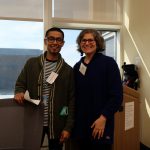
present fellows that centers migration as a lens through which to investigate and rethink American history. Whether individuals wanted to move, were enslaved, were incorporated into a nation state, or were already in North America, the United States is a product of unique migration and immigration stories. Most visitors will spy an artifact or label relevant to their family’s travel journey while others will simply be transported, lost in the trials and successes and perseverance of distinct communities.
For these reasons and more, Dr. Serrano shared “Becoming Us: Teacher Resources for a More Accurate and Inclusive Migration and Immigration Narrative.” Built upon 10 “essential understandings,” this electronic resource is designed with the Social Studies educator in mind, but the content is rife with opportunity for all.
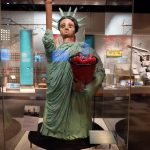 Instructors in a last-minute lesson-planning bind could find a foothold for these impressive resources in their classroom, of course. But, let’s not forget the transformative experience of visiting the exhibit itself. While Dr. Serrano shared some of his favorite artifacts, including the Immokalee Statue of Liberty, the fellows could be found exploring the interactive video tower dedicated to Indian boarding schools, learning more about segregation in the context of baseball, or studying a selection of items left behind by desperate, hopeful seekers in the Arizona desert.
Instructors in a last-minute lesson-planning bind could find a foothold for these impressive resources in their classroom, of course. But, let’s not forget the transformative experience of visiting the exhibit itself. While Dr. Serrano shared some of his favorite artifacts, including the Immokalee Statue of Liberty, the fellows could be found exploring the interactive video tower dedicated to Indian boarding schools, learning more about segregation in the context of baseball, or studying a selection of items left behind by desperate, hopeful seekers in the Arizona desert.
For fellow Teresa Lew, a professor in MC’s English and Reading Department, the Juki industrial sewing machine as well as other objects displayed in the same case, inspired her thinking about her semester project: “As the object label explains, seventy-two undocumented Thai immigrants were held captive and forced to work up to eighteen hours a day in this illegal clothing factory. Alongside this sewing station was a button-down shirt from the Triangle Shirtwaist Company where 150 immigrant workers died in a factory fire in NYC in 1911. I immediately saw the relevance of this display with ENGL 102 since the issue of fast fashion and sweatshop labor is commonly discussed in the course. I also imagine a number of my current students would be surprised to learn about the history of sweatshops in the U.S. since many tend to associate the problem with poorer developing countries.”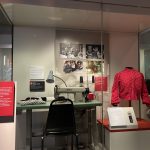
As Teresa underscores, the artifacts on display are hard-hitting and inspiring, easily influencing the conversations shared between the fellows and their guides as they wandered the space.
What items would you bring with you if leaving home became necessary?
What personal family object do you consider culturally significant and worthy of public display?
What objects/ stories are missing from this exhibit space?
Fellow Evan Crump of MC’s English and Reading Department pointed to the magnitude of the Smithsonian’s role in revisiting history in this critical way: “I was struck by how difficult it must be for Smithsonian education partners to present historical truths from underrepresented perspectives in a political climate that, in many parts of the country, wants to keep their heads in the sand about the uncomfortable realities of our nation’s past. The old adage is that the winners write the history books; what happens when a government-funded institution starts examining those narratives through a critical lens?”
For the Smithsonian Faculty Fellowship, at least, we know Many Voices, One Nation has uncovered rewarding pathways for debate, critical thinking, reflection, and more for this cohort and their students.
Before we could fully unpack our first exhibit experience, we were invited to explore the glitz, gloom, glamour, and grime of Entertainment Nation, which opened in December 2022. And, while that series
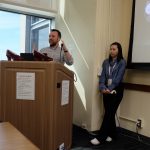
of alliterative adjectives will potentially confuse readers, the exhibit does not glamorize Hollywood without acknowledging a seedy history of injustices, stereotypes, and silences irrevocably tied to the world of American entertainment. In place of Dr. Theodore Gonzalves—who was unfortunately unavailable due to jury duty—his colleagues Ryan Lintelman, a Curator of Entertainment Nation and a historian of American entertainment, and Thanh Lieu, a Museum Technician, stepped in and even brought a replica pair of ruby slippers with them! Lintelman explained the exhibit took over 20 years to create. Determining the stories to tell, shaping how comprehensive the space could be, defining the timelines—these represent only a selection of the challenges the curators faced.
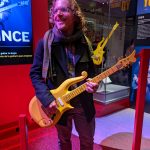 Fortunately, the outcomes of their ultimate decisions make for quite a spectacle today. Entertainment Nation is a playground for all. Kids of every age will discover an artifact from their youth, whether it be Kermit the Frog and Miss Piggy, Prince’s Yellow Cloud Electric Guitar (You will spy Professor Ted Shusterman shredding away at a 3-D printed replica in this post’s photos, in fact!), or—a personal favorite—a prop egg from the Alien 3 trailer. For Teresa Lew, objects representing the Asian-American experience in both exhibits grabbed her attention: “I was delighted to see Kristi Yamaguchi’s figure skates (Many Voices), Constance Wu’s blue dress from the wedding scene in Crazy Rich Asians, and Anna May Wong’s makeup mirror (both in Entertainment Nation).” There is simply so much to see and experience! At one point, I recall being overwhelmed by a collision of sights and sounds as various field trip kids rushed to take photos with R2-D2 and C-3PO while starfighters in battle blared from the exhibit’s impressive speaker system above.
Fortunately, the outcomes of their ultimate decisions make for quite a spectacle today. Entertainment Nation is a playground for all. Kids of every age will discover an artifact from their youth, whether it be Kermit the Frog and Miss Piggy, Prince’s Yellow Cloud Electric Guitar (You will spy Professor Ted Shusterman shredding away at a 3-D printed replica in this post’s photos, in fact!), or—a personal favorite—a prop egg from the Alien 3 trailer. For Teresa Lew, objects representing the Asian-American experience in both exhibits grabbed her attention: “I was delighted to see Kristi Yamaguchi’s figure skates (Many Voices), Constance Wu’s blue dress from the wedding scene in Crazy Rich Asians, and Anna May Wong’s makeup mirror (both in Entertainment Nation).” There is simply so much to see and experience! At one point, I recall being overwhelmed by a collision of sights and sounds as various field trip kids rushed to take photos with R2-D2 and C-3PO while starfighters in battle blared from the exhibit’s impressive speaker system above.
It’s not all fun and games in Entertainment Nation, though, and, as visitors walk the red carpet—just one of many intentional design elements in the space—they will encounter thought-provoking content intended to decenter white narratives. One media-driven alcove puts a spotlight on comedians of color and shares snippets of their routines that reclaim identity and address stereotypes. Many comedy routines throughout American entertainment history pivoted on a white comic performing a caricature of the cultural “other,” and the video showed how often blackface and other thoughtless portrayals of race were the joke of the time. Even the celebrated Judy Garland, who is symbolically represented in the exhibit through those infamous ruby slippers, is shown in blackface as she performs “Swing Low, Sweet Chariot” in the 1938 musical Everybody Sing.
Whether drawn to Many Voices, One Nation or Entertainment Nation, museum-goers will find the curating teams did not shy away from asking hard questions. Both document the challenges of the past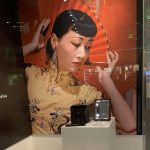 while creating opportunities for inclusivity in the stories they seek to recover and showcase. The story of Anna May Wong is perhaps one of the more unique ties that unites both exhibits and their respective missions. Considered the first Chinese American film star of the 1920s and 1930s, Wong found fame while growing up in Los Angeles. The daughter of second-generation immigrants who ran a laundry business, Wong was quick to proclaim her desire to be a star and soon achieved her dream in 1919. The career that followed was often unkind, though, forcing Wong into stereotypical and exaggerated racial roles. She is even quoted to have said, “When I die, my epitaph should be: ‘I died a thousand deaths.’ That was the story of my film career.”
while creating opportunities for inclusivity in the stories they seek to recover and showcase. The story of Anna May Wong is perhaps one of the more unique ties that unites both exhibits and their respective missions. Considered the first Chinese American film star of the 1920s and 1930s, Wong found fame while growing up in Los Angeles. The daughter of second-generation immigrants who ran a laundry business, Wong was quick to proclaim her desire to be a star and soon achieved her dream in 1919. The career that followed was often unkind, though, forcing Wong into stereotypical and exaggerated racial roles. She is even quoted to have said, “When I die, my epitaph should be: ‘I died a thousand deaths.’ That was the story of my film career.”
For many, it is an unfamiliar story, but the Smithsonian National Museum of American History has invited countless visitors to recognize Wong’s enduring contribution to the film industry as well as her value as a trailblazer trapped in a dark time.
To learn more about our visit, please explore Philippa Rappoport’s Smithsonian Learning Lab collection, which serves as the fellows’ introduction to both Many Voices, One Nation and Entertainment Nation: https://learninglab.si.edu/collections/2024-smithsonian-montgomery-college-faculty-fellowship-program-national-museum-of-american-history/stU7qKde9ORINVu8.
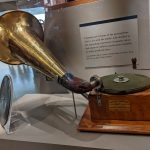 By the Way! Several fellows visited the museum prior to our guided tour and spoke to the power of the Smithsonian National Museum of American History’s other exhibits, including America’s Listening. Theodore Shusterman shares, “… just around the corner from Entertainment Nation is the America’s Listening exhibit, which features examples of the earliest recording technologies: Thomas Edison’s tin-foil and wax-cylinder phonographs; Alexander Graham Bell’s graphophone; and Emile Berliner’s flat gramophone disc, which is what we now recognize as a ‘record’ when someone refers to playing records. The ability to record and playback sound has only been around since the late nineteenth century, yet its presence in society is ubiquitous and often taken for granted.” Perhaps, like Ted, our readers will find inspiration in this exhibit space
By the Way! Several fellows visited the museum prior to our guided tour and spoke to the power of the Smithsonian National Museum of American History’s other exhibits, including America’s Listening. Theodore Shusterman shares, “… just around the corner from Entertainment Nation is the America’s Listening exhibit, which features examples of the earliest recording technologies: Thomas Edison’s tin-foil and wax-cylinder phonographs; Alexander Graham Bell’s graphophone; and Emile Berliner’s flat gramophone disc, which is what we now recognize as a ‘record’ when someone refers to playing records. The ability to record and playback sound has only been around since the late nineteenth century, yet its presence in society is ubiquitous and often taken for granted.” Perhaps, like Ted, our readers will find inspiration in this exhibit space
Photos by Denise Dewhurst
Photos by Matt Decker
Photos by Teresa Lew
Photos by Ted Shusterman





A RETROSPECTIVE
I have been to the NMAH several times as a previous fellow and with friends and students. Each time takes me into new thoughts and ideas. This is proof of the value of the museums to endlessly stimulate
Following John Falk, I believe that modern museums are not just repositories of information but a way to self reflect on personal identity
My work in narrative supports this theoretical stance
This time, together with new and very thoughtful colleagues and old friends, I had a completely different experience. The no visit years during the pandemic and after were a good “restart” for me. As my most beloved author Marcel Proust said, to paraphrase, the voyage of discovery is not one of going to new places but looking with new eyes
With this in mind, the museum experience was one of seeing the two exhibitions holistically
I felt I was walking through the entire history of social justice as it developed in the USA
This was a revelation for me
A reason to return again with that in mind
Thank you for sharing, Serena! I agree: It’s so interesting to recognize the unique artifacts that grab my attention with each visit. While that “phenomenon” could be explained away by the sheer number of items and stories on display, I know the objects that stop me in my tracks are tied to where I am and how I find myself in that moment. “Looking with new eyes” captures this experience beautifully.
I love reading your posts to re-experience all the rich moments from our museum visits! Just one minor correction: the Kristi Yamaguchi figure skates can be seen at the end of the Many Nations, One Voice exhibit not the Entertainment Nation exhibit.
Thanks Teresa- I will correct- DD
[…] of course, there’s the picture of me posing with the guitar in the March 27, 2024 SFF Blog Post of our cohort’s visit to […]